MSc Clinical Medicine: Clinical Practice Module 7LM0156 Portfolio
VerifiedAdded on 2023/06/15
|21
|7630
|265
Portfolio
AI Summary
This portfolio documents a student's learning experience during cardiology and stroke placements as part of an MSc in Clinical Medicine. It includes reflections on initial expectations, daily learning logs detailing observations of patient care and treatment methods, and a final review comparing the placement experience to the NHS. The portfolio also explores interprofessional teamwork, highlighting its importance in providing quality patient care through coordinated efforts of various healthcare professionals like physiotherapists, neurologists, and nurses. Examples of multidisciplinary collaboration, such as emergency responses to cardiac arrests, are discussed, emphasizing the value of teamwork in managing critical situations and improving patient outcomes. The student reflects on the differences in healthcare delivery between the placement and the NHS, noting the resources and expertise available in the latter.
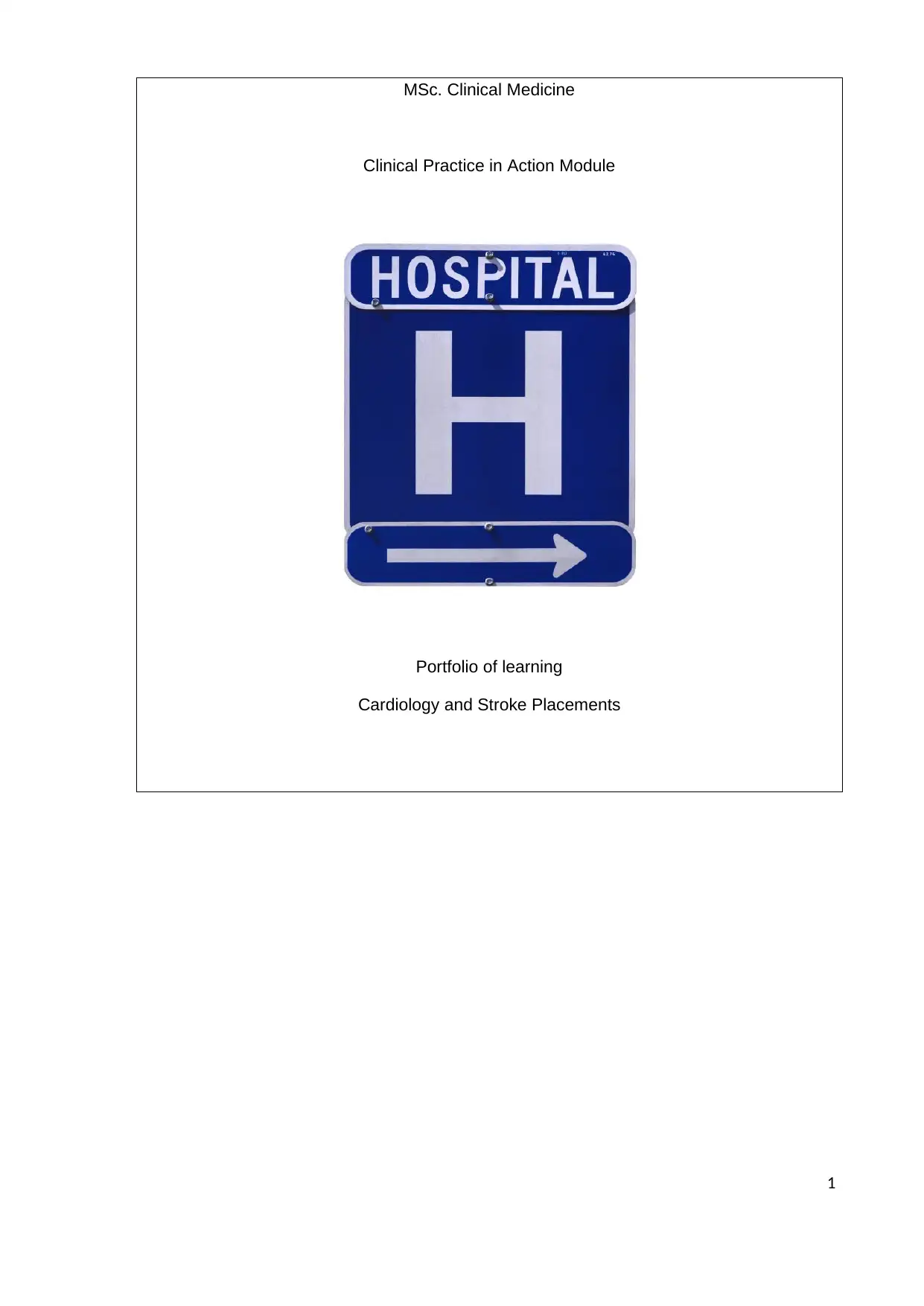
MSc. Clinical Medicine
Clinical Practice in Action Module
Portfolio of learning
Cardiology and Stroke Placements
1
Clinical Practice in Action Module
Portfolio of learning
Cardiology and Stroke Placements
1
Paraphrase This Document
Need a fresh take? Get an instant paraphrase of this document with our AI Paraphraser
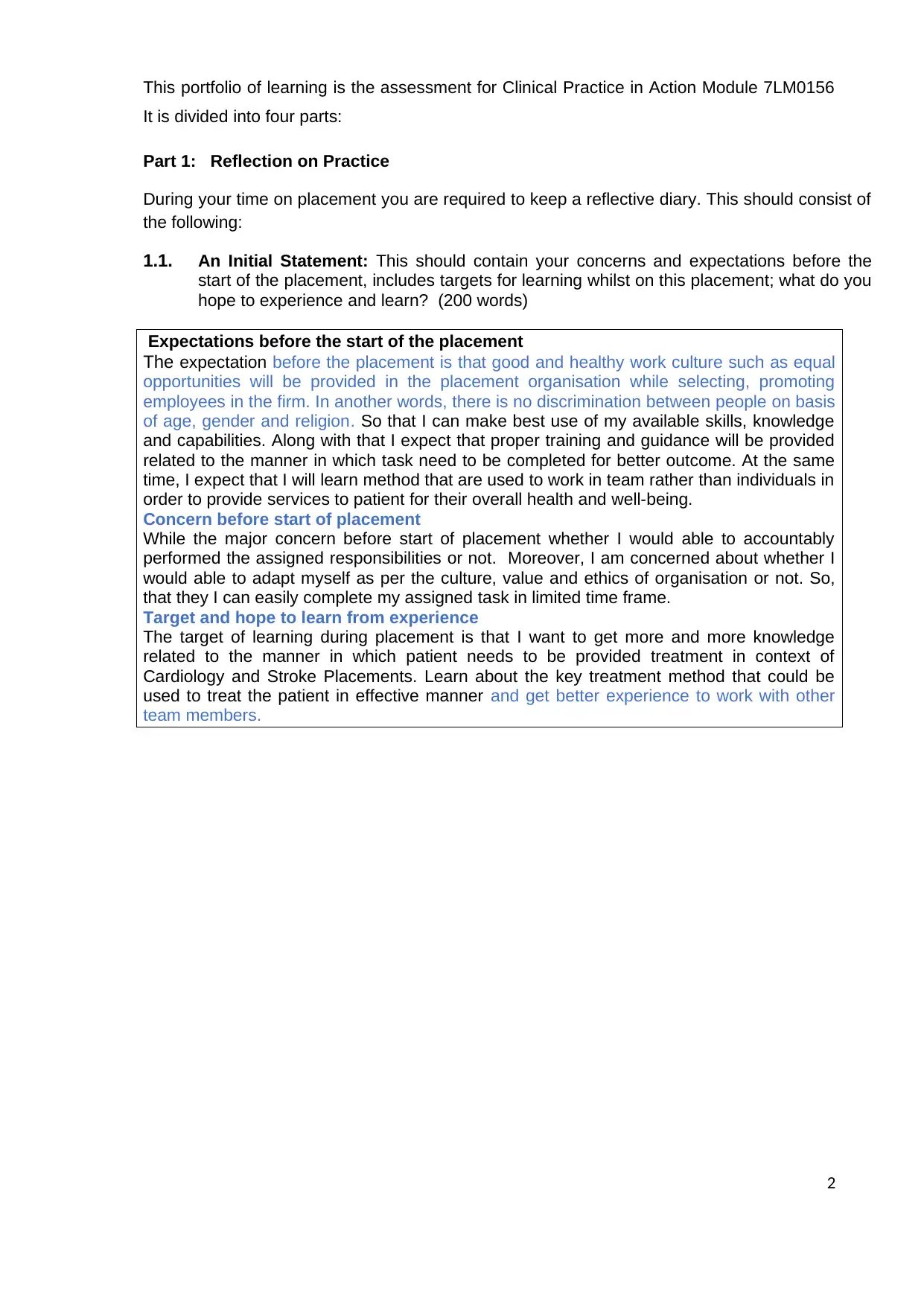
This portfolio of learning is the assessment for Clinical Practice in Action Module 7LM0156
It is divided into four parts:
Part 1: Reflection on Practice
During your time on placement you are required to keep a reflective diary. This should consist of
the following:
1.1. An Initial Statement: This should contain your concerns and expectations before the
start of the placement, includes targets for learning whilst on this placement; what do you
hope to experience and learn? (200 words)
Expectations before the start of the placement
The expectation before the placement is that good and healthy work culture such as equal
opportunities will be provided in the placement organisation while selecting, promoting
employees in the firm. In another words, there is no discrimination between people on basis
of age, gender and religion. So that I can make best use of my available skills, knowledge
and capabilities. Along with that I expect that proper training and guidance will be provided
related to the manner in which task need to be completed for better outcome. At the same
time, I expect that I will learn method that are used to work in team rather than individuals in
order to provide services to patient for their overall health and well-being.
Concern before start of placement
While the major concern before start of placement whether I would able to accountably
performed the assigned responsibilities or not. Moreover, I am concerned about whether I
would able to adapt myself as per the culture, value and ethics of organisation or not. So,
that they I can easily complete my assigned task in limited time frame.
Target and hope to learn from experience
The target of learning during placement is that I want to get more and more knowledge
related to the manner in which patient needs to be provided treatment in context of
Cardiology and Stroke Placements. Learn about the key treatment method that could be
used to treat the patient in effective manner and get better experience to work with other
team members.
2
It is divided into four parts:
Part 1: Reflection on Practice
During your time on placement you are required to keep a reflective diary. This should consist of
the following:
1.1. An Initial Statement: This should contain your concerns and expectations before the
start of the placement, includes targets for learning whilst on this placement; what do you
hope to experience and learn? (200 words)
Expectations before the start of the placement
The expectation before the placement is that good and healthy work culture such as equal
opportunities will be provided in the placement organisation while selecting, promoting
employees in the firm. In another words, there is no discrimination between people on basis
of age, gender and religion. So that I can make best use of my available skills, knowledge
and capabilities. Along with that I expect that proper training and guidance will be provided
related to the manner in which task need to be completed for better outcome. At the same
time, I expect that I will learn method that are used to work in team rather than individuals in
order to provide services to patient for their overall health and well-being.
Concern before start of placement
While the major concern before start of placement whether I would able to accountably
performed the assigned responsibilities or not. Moreover, I am concerned about whether I
would able to adapt myself as per the culture, value and ethics of organisation or not. So,
that they I can easily complete my assigned task in limited time frame.
Target and hope to learn from experience
The target of learning during placement is that I want to get more and more knowledge
related to the manner in which patient needs to be provided treatment in context of
Cardiology and Stroke Placements. Learn about the key treatment method that could be
used to treat the patient in effective manner and get better experience to work with other
team members.
2

3
⊘ This is a preview!⊘
Do you want full access?
Subscribe today to unlock all pages.

Trusted by 1+ million students worldwide
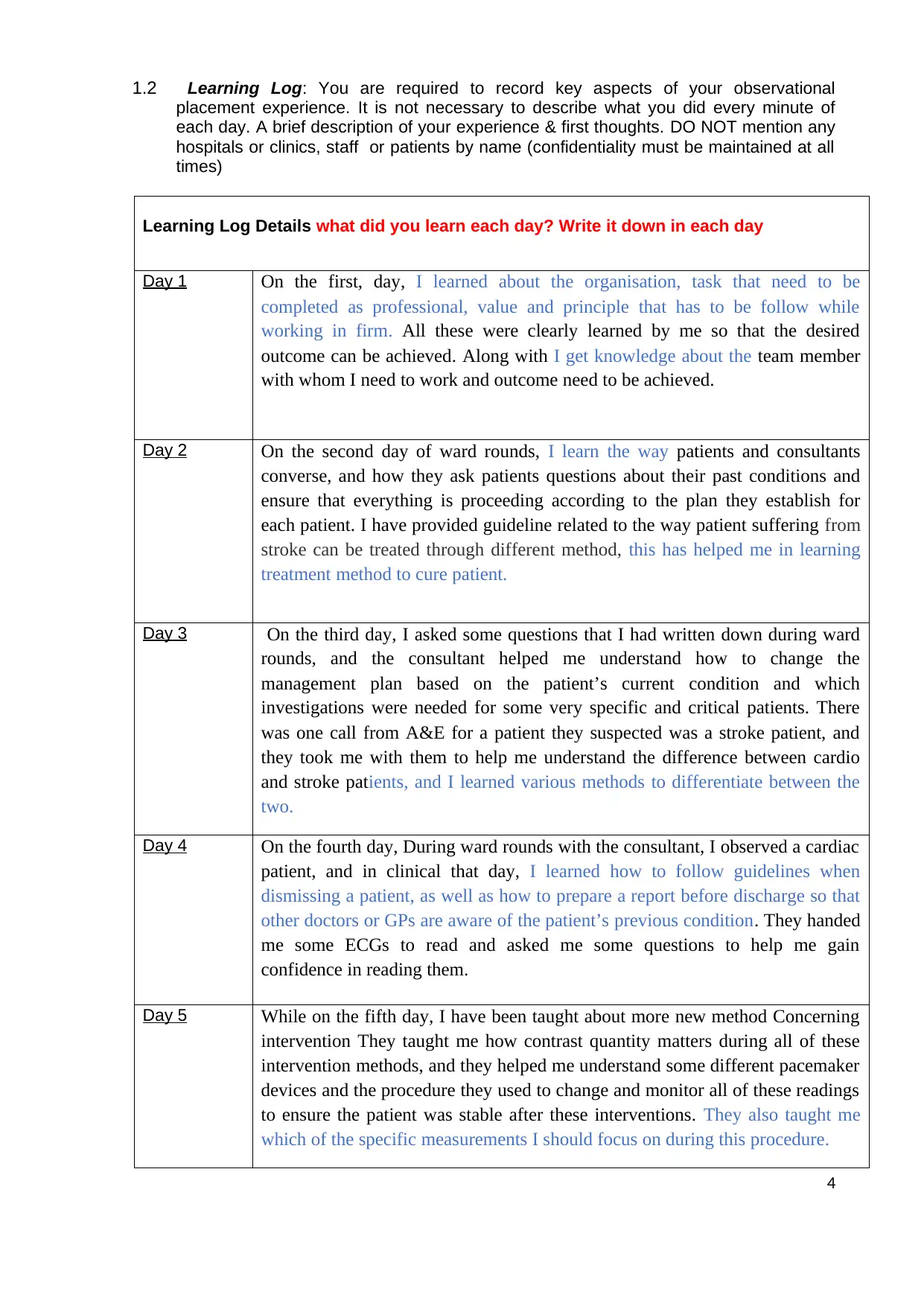
1.2 Learning Log: You are required to record key aspects of your observational
placement experience. It is not necessary to describe what you did every minute of
each day. A brief description of your experience & first thoughts. DO NOT mention any
hospitals or clinics, staff or patients by name (confidentiality must be maintained at all
times)
Learning Log Details what did you learn each day? Write it down in each day
Day 1 On the first, day, I learned about the organisation, task that need to be
completed as professional, value and principle that has to be follow while
working in firm. All these were clearly learned by me so that the desired
outcome can be achieved. Along with I get knowledge about the team member
with whom I need to work and outcome need to be achieved.
Day 2 On the second day of ward rounds, I learn the way patients and consultants
converse, and how they ask patients questions about their past conditions and
ensure that everything is proceeding according to the plan they establish for
each patient. I have provided guideline related to the way patient suffering from
stroke can be treated through different method, this has helped me in learning
treatment method to cure patient.
Day 3 On the third day, I asked some questions that I had written down during ward
rounds, and the consultant helped me understand how to change the
management plan based on the patient’s current condition and which
investigations were needed for some very specific and critical patients. There
was one call from A&E for a patient they suspected was a stroke patient, and
they took me with them to help me understand the difference between cardio
and stroke patients, and I learned various methods to differentiate between the
two.
Day 4 On the fourth day, During ward rounds with the consultant, I observed a cardiac
patient, and in clinical that day, I learned how to follow guidelines when
dismissing a patient, as well as how to prepare a report before discharge so that
other doctors or GPs are aware of the patient’s previous condition. They handed
me some ECGs to read and asked me some questions to help me gain
confidence in reading them.
Day 5 While on the fifth day, I have been taught about more new method Concerning
intervention They taught me how contrast quantity matters during all of these
intervention methods, and they helped me understand some different pacemaker
devices and the procedure they used to change and monitor all of these readings
to ensure the patient was stable after these interventions. They also taught me
which of the specific measurements I should focus on during this procedure.
4
placement experience. It is not necessary to describe what you did every minute of
each day. A brief description of your experience & first thoughts. DO NOT mention any
hospitals or clinics, staff or patients by name (confidentiality must be maintained at all
times)
Learning Log Details what did you learn each day? Write it down in each day
Day 1 On the first, day, I learned about the organisation, task that need to be
completed as professional, value and principle that has to be follow while
working in firm. All these were clearly learned by me so that the desired
outcome can be achieved. Along with I get knowledge about the team member
with whom I need to work and outcome need to be achieved.
Day 2 On the second day of ward rounds, I learn the way patients and consultants
converse, and how they ask patients questions about their past conditions and
ensure that everything is proceeding according to the plan they establish for
each patient. I have provided guideline related to the way patient suffering from
stroke can be treated through different method, this has helped me in learning
treatment method to cure patient.
Day 3 On the third day, I asked some questions that I had written down during ward
rounds, and the consultant helped me understand how to change the
management plan based on the patient’s current condition and which
investigations were needed for some very specific and critical patients. There
was one call from A&E for a patient they suspected was a stroke patient, and
they took me with them to help me understand the difference between cardio
and stroke patients, and I learned various methods to differentiate between the
two.
Day 4 On the fourth day, During ward rounds with the consultant, I observed a cardiac
patient, and in clinical that day, I learned how to follow guidelines when
dismissing a patient, as well as how to prepare a report before discharge so that
other doctors or GPs are aware of the patient’s previous condition. They handed
me some ECGs to read and asked me some questions to help me gain
confidence in reading them.
Day 5 While on the fifth day, I have been taught about more new method Concerning
intervention They taught me how contrast quantity matters during all of these
intervention methods, and they helped me understand some different pacemaker
devices and the procedure they used to change and monitor all of these readings
to ensure the patient was stable after these interventions. They also taught me
which of the specific measurements I should focus on during this procedure.
4
Paraphrase This Document
Need a fresh take? Get an instant paraphrase of this document with our AI Paraphraser
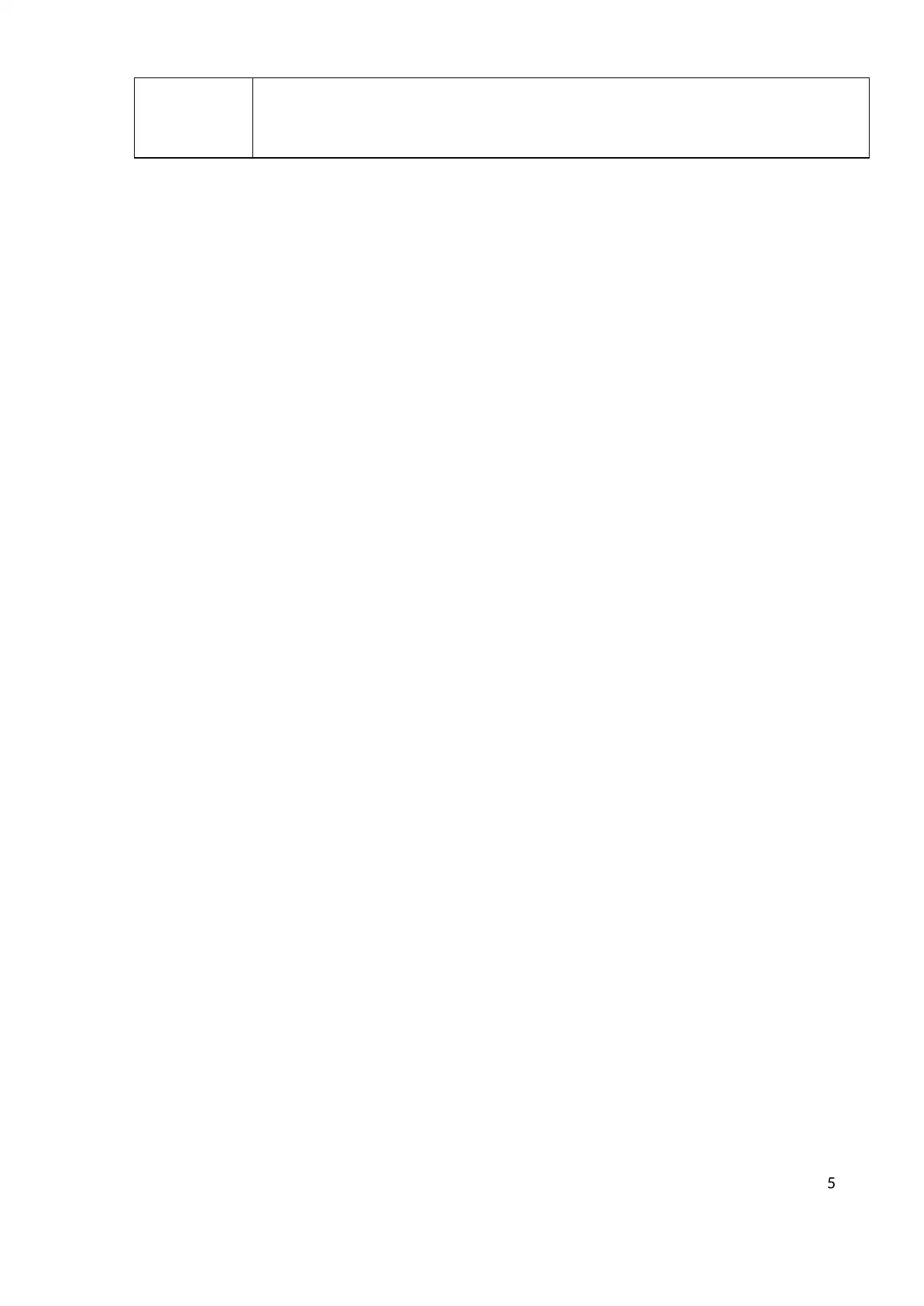
5
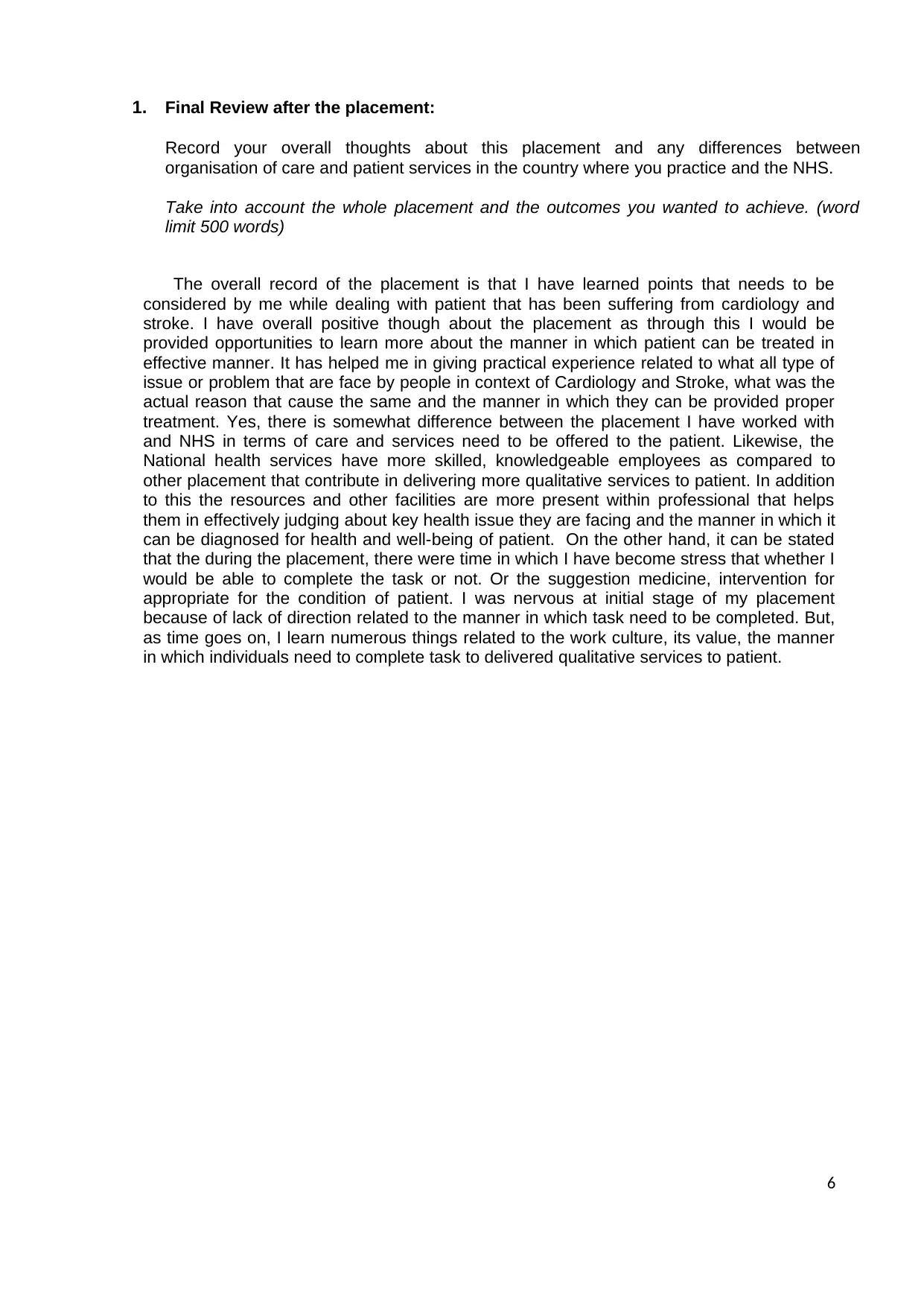
1. Final Review after the placement:
Record your overall thoughts about this placement and any differences between
organisation of care and patient services in the country where you practice and the NHS.
Take into account the whole placement and the outcomes you wanted to achieve. (word
limit 500 words)
The overall record of the placement is that I have learned points that needs to be
considered by me while dealing with patient that has been suffering from cardiology and
stroke. I have overall positive though about the placement as through this I would be
provided opportunities to learn more about the manner in which patient can be treated in
effective manner. It has helped me in giving practical experience related to what all type of
issue or problem that are face by people in context of Cardiology and Stroke, what was the
actual reason that cause the same and the manner in which they can be provided proper
treatment. Yes, there is somewhat difference between the placement I have worked with
and NHS in terms of care and services need to be offered to the patient. Likewise, the
National health services have more skilled, knowledgeable employees as compared to
other placement that contribute in delivering more qualitative services to patient. In addition
to this the resources and other facilities are more present within professional that helps
them in effectively judging about key health issue they are facing and the manner in which it
can be diagnosed for health and well-being of patient. On the other hand, it can be stated
that the during the placement, there were time in which I have become stress that whether I
would be able to complete the task or not. Or the suggestion medicine, intervention for
appropriate for the condition of patient. I was nervous at initial stage of my placement
because of lack of direction related to the manner in which task need to be completed. But,
as time goes on, I learn numerous things related to the work culture, its value, the manner
in which individuals need to complete task to delivered qualitative services to patient.
6
Record your overall thoughts about this placement and any differences between
organisation of care and patient services in the country where you practice and the NHS.
Take into account the whole placement and the outcomes you wanted to achieve. (word
limit 500 words)
The overall record of the placement is that I have learned points that needs to be
considered by me while dealing with patient that has been suffering from cardiology and
stroke. I have overall positive though about the placement as through this I would be
provided opportunities to learn more about the manner in which patient can be treated in
effective manner. It has helped me in giving practical experience related to what all type of
issue or problem that are face by people in context of Cardiology and Stroke, what was the
actual reason that cause the same and the manner in which they can be provided proper
treatment. Yes, there is somewhat difference between the placement I have worked with
and NHS in terms of care and services need to be offered to the patient. Likewise, the
National health services have more skilled, knowledgeable employees as compared to
other placement that contribute in delivering more qualitative services to patient. In addition
to this the resources and other facilities are more present within professional that helps
them in effectively judging about key health issue they are facing and the manner in which it
can be diagnosed for health and well-being of patient. On the other hand, it can be stated
that the during the placement, there were time in which I have become stress that whether I
would be able to complete the task or not. Or the suggestion medicine, intervention for
appropriate for the condition of patient. I was nervous at initial stage of my placement
because of lack of direction related to the manner in which task need to be completed. But,
as time goes on, I learn numerous things related to the work culture, its value, the manner
in which individuals need to complete task to delivered qualitative services to patient.
6
⊘ This is a preview!⊘
Do you want full access?
Subscribe today to unlock all pages.

Trusted by 1+ million students worldwide

7
Paraphrase This Document
Need a fresh take? Get an instant paraphrase of this document with our AI Paraphraser
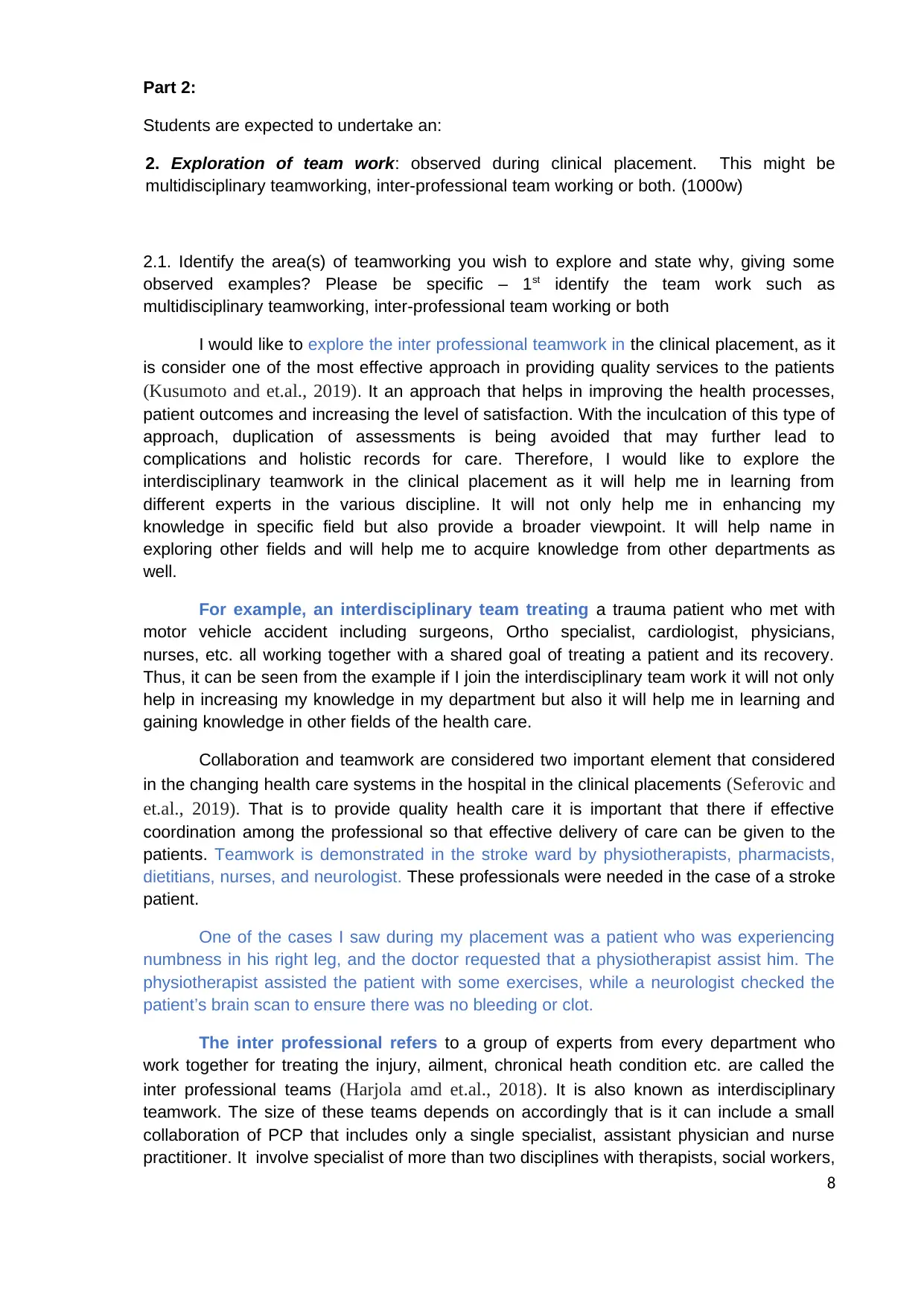
Part 2:
Students are expected to undertake an:
2. Exploration of team work: observed during clinical placement. This might be
multidisciplinary teamworking, inter-professional team working or both. (1000w)
2.1. Identify the area(s) of teamworking you wish to explore and state why, giving some
observed examples? Please be specific – 1st identify the team work such as
multidisciplinary teamworking, inter-professional team working or both
I would like to explore the inter professional teamwork in the clinical placement, as it
is consider one of the most effective approach in providing quality services to the patients
(Kusumoto and et.al., 2019). It an approach that helps in improving the health processes,
patient outcomes and increasing the level of satisfaction. With the inculcation of this type of
approach, duplication of assessments is being avoided that may further lead to
complications and holistic records for care. Therefore, I would like to explore the
interdisciplinary teamwork in the clinical placement as it will help me in learning from
different experts in the various discipline. It will not only help me in enhancing my
knowledge in specific field but also provide a broader viewpoint. It will help name in
exploring other fields and will help me to acquire knowledge from other departments as
well.
For example, an interdisciplinary team treating a trauma patient who met with
motor vehicle accident including surgeons, Ortho specialist, cardiologist, physicians,
nurses, etc. all working together with a shared goal of treating a patient and its recovery.
Thus, it can be seen from the example if I join the interdisciplinary team work it will not only
help in increasing my knowledge in my department but also it will help me in learning and
gaining knowledge in other fields of the health care.
Collaboration and teamwork are considered two important element that considered
in the changing health care systems in the hospital in the clinical placements (Seferovic and
et.al., 2019). That is to provide quality health care it is important that there if effective
coordination among the professional so that effective delivery of care can be given to the
patients. Teamwork is demonstrated in the stroke ward by physiotherapists, pharmacists,
dietitians, nurses, and neurologist. These professionals were needed in the case of a stroke
patient.
One of the cases I saw during my placement was a patient who was experiencing
numbness in his right leg, and the doctor requested that a physiotherapist assist him. The
physiotherapist assisted the patient with some exercises, while a neurologist checked the
patient’s brain scan to ensure there was no bleeding or clot.
The inter professional refers to a group of experts from every department who
work together for treating the injury, ailment, chronical heath condition etc. are called the
inter professional teams (Harjola amd et.al., 2018). It is also known as interdisciplinary
teamwork. The size of these teams depends on accordingly that is it can include a small
collaboration of PCP that includes only a single specialist, assistant physician and nurse
practitioner. It involve specialist of more than two disciplines with therapists, social workers,
8
Students are expected to undertake an:
2. Exploration of team work: observed during clinical placement. This might be
multidisciplinary teamworking, inter-professional team working or both. (1000w)
2.1. Identify the area(s) of teamworking you wish to explore and state why, giving some
observed examples? Please be specific – 1st identify the team work such as
multidisciplinary teamworking, inter-professional team working or both
I would like to explore the inter professional teamwork in the clinical placement, as it
is consider one of the most effective approach in providing quality services to the patients
(Kusumoto and et.al., 2019). It an approach that helps in improving the health processes,
patient outcomes and increasing the level of satisfaction. With the inculcation of this type of
approach, duplication of assessments is being avoided that may further lead to
complications and holistic records for care. Therefore, I would like to explore the
interdisciplinary teamwork in the clinical placement as it will help me in learning from
different experts in the various discipline. It will not only help me in enhancing my
knowledge in specific field but also provide a broader viewpoint. It will help name in
exploring other fields and will help me to acquire knowledge from other departments as
well.
For example, an interdisciplinary team treating a trauma patient who met with
motor vehicle accident including surgeons, Ortho specialist, cardiologist, physicians,
nurses, etc. all working together with a shared goal of treating a patient and its recovery.
Thus, it can be seen from the example if I join the interdisciplinary team work it will not only
help in increasing my knowledge in my department but also it will help me in learning and
gaining knowledge in other fields of the health care.
Collaboration and teamwork are considered two important element that considered
in the changing health care systems in the hospital in the clinical placements (Seferovic and
et.al., 2019). That is to provide quality health care it is important that there if effective
coordination among the professional so that effective delivery of care can be given to the
patients. Teamwork is demonstrated in the stroke ward by physiotherapists, pharmacists,
dietitians, nurses, and neurologist. These professionals were needed in the case of a stroke
patient.
One of the cases I saw during my placement was a patient who was experiencing
numbness in his right leg, and the doctor requested that a physiotherapist assist him. The
physiotherapist assisted the patient with some exercises, while a neurologist checked the
patient’s brain scan to ensure there was no bleeding or clot.
The inter professional refers to a group of experts from every department who
work together for treating the injury, ailment, chronical heath condition etc. are called the
inter professional teams (Harjola amd et.al., 2018). It is also known as interdisciplinary
teamwork. The size of these teams depends on accordingly that is it can include a small
collaboration of PCP that includes only a single specialist, assistant physician and nurse
practitioner. It involve specialist of more than two disciplines with therapists, social workers,
8
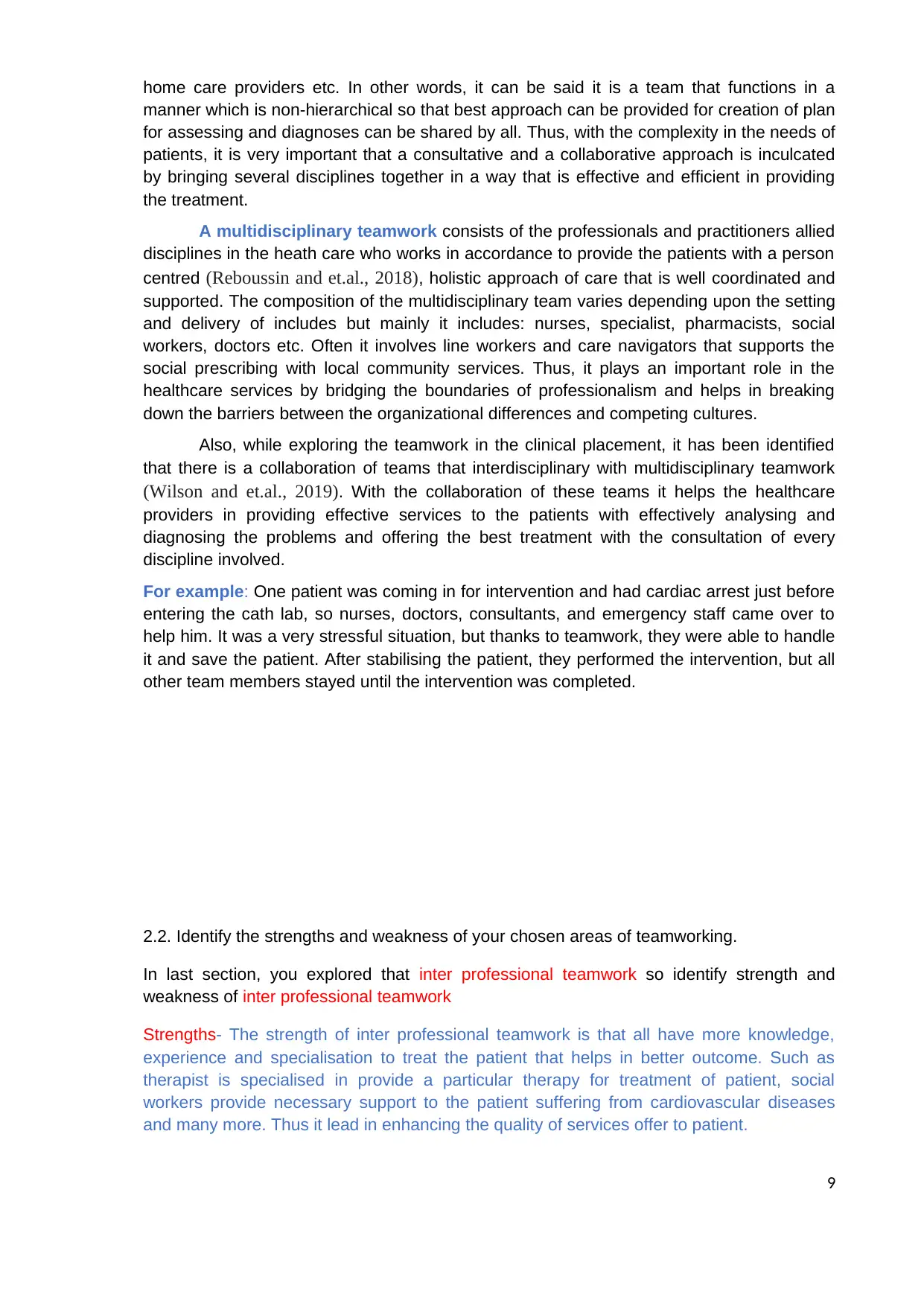
home care providers etc. In other words, it can be said it is a team that functions in a
manner which is non-hierarchical so that best approach can be provided for creation of plan
for assessing and diagnoses can be shared by all. Thus, with the complexity in the needs of
patients, it is very important that a consultative and a collaborative approach is inculcated
by bringing several disciplines together in a way that is effective and efficient in providing
the treatment.
A multidisciplinary teamwork consists of the professionals and practitioners allied
disciplines in the heath care who works in accordance to provide the patients with a person
centred (Reboussin and et.al., 2018), holistic approach of care that is well coordinated and
supported. The composition of the multidisciplinary team varies depending upon the setting
and delivery of includes but mainly it includes: nurses, specialist, pharmacists, social
workers, doctors etc. Often it involves line workers and care navigators that supports the
social prescribing with local community services. Thus, it plays an important role in the
healthcare services by bridging the boundaries of professionalism and helps in breaking
down the barriers between the organizational differences and competing cultures.
Also, while exploring the teamwork in the clinical placement, it has been identified
that there is a collaboration of teams that interdisciplinary with multidisciplinary teamwork
(Wilson and et.al., 2019). With the collaboration of these teams it helps the healthcare
providers in providing effective services to the patients with effectively analysing and
diagnosing the problems and offering the best treatment with the consultation of every
discipline involved.
For example: One patient was coming in for intervention and had cardiac arrest just before
entering the cath lab, so nurses, doctors, consultants, and emergency staff came over to
help him. It was a very stressful situation, but thanks to teamwork, they were able to handle
it and save the patient. After stabilising the patient, they performed the intervention, but all
other team members stayed until the intervention was completed.
2.2. Identify the strengths and weakness of your chosen areas of teamworking.
In last section, you explored that inter professional teamwork so identify strength and
weakness of inter professional teamwork
Strengths- The strength of inter professional teamwork is that all have more knowledge,
experience and specialisation to treat the patient that helps in better outcome. Such as
therapist is specialised in provide a particular therapy for treatment of patient, social
workers provide necessary support to the patient suffering from cardiovascular diseases
and many more. Thus it lead in enhancing the quality of services offer to patient.
9
manner which is non-hierarchical so that best approach can be provided for creation of plan
for assessing and diagnoses can be shared by all. Thus, with the complexity in the needs of
patients, it is very important that a consultative and a collaborative approach is inculcated
by bringing several disciplines together in a way that is effective and efficient in providing
the treatment.
A multidisciplinary teamwork consists of the professionals and practitioners allied
disciplines in the heath care who works in accordance to provide the patients with a person
centred (Reboussin and et.al., 2018), holistic approach of care that is well coordinated and
supported. The composition of the multidisciplinary team varies depending upon the setting
and delivery of includes but mainly it includes: nurses, specialist, pharmacists, social
workers, doctors etc. Often it involves line workers and care navigators that supports the
social prescribing with local community services. Thus, it plays an important role in the
healthcare services by bridging the boundaries of professionalism and helps in breaking
down the barriers between the organizational differences and competing cultures.
Also, while exploring the teamwork in the clinical placement, it has been identified
that there is a collaboration of teams that interdisciplinary with multidisciplinary teamwork
(Wilson and et.al., 2019). With the collaboration of these teams it helps the healthcare
providers in providing effective services to the patients with effectively analysing and
diagnosing the problems and offering the best treatment with the consultation of every
discipline involved.
For example: One patient was coming in for intervention and had cardiac arrest just before
entering the cath lab, so nurses, doctors, consultants, and emergency staff came over to
help him. It was a very stressful situation, but thanks to teamwork, they were able to handle
it and save the patient. After stabilising the patient, they performed the intervention, but all
other team members stayed until the intervention was completed.
2.2. Identify the strengths and weakness of your chosen areas of teamworking.
In last section, you explored that inter professional teamwork so identify strength and
weakness of inter professional teamwork
Strengths- The strength of inter professional teamwork is that all have more knowledge,
experience and specialisation to treat the patient that helps in better outcome. Such as
therapist is specialised in provide a particular therapy for treatment of patient, social
workers provide necessary support to the patient suffering from cardiovascular diseases
and many more. Thus it lead in enhancing the quality of services offer to patient.
9
⊘ This is a preview!⊘
Do you want full access?
Subscribe today to unlock all pages.

Trusted by 1+ million students worldwide
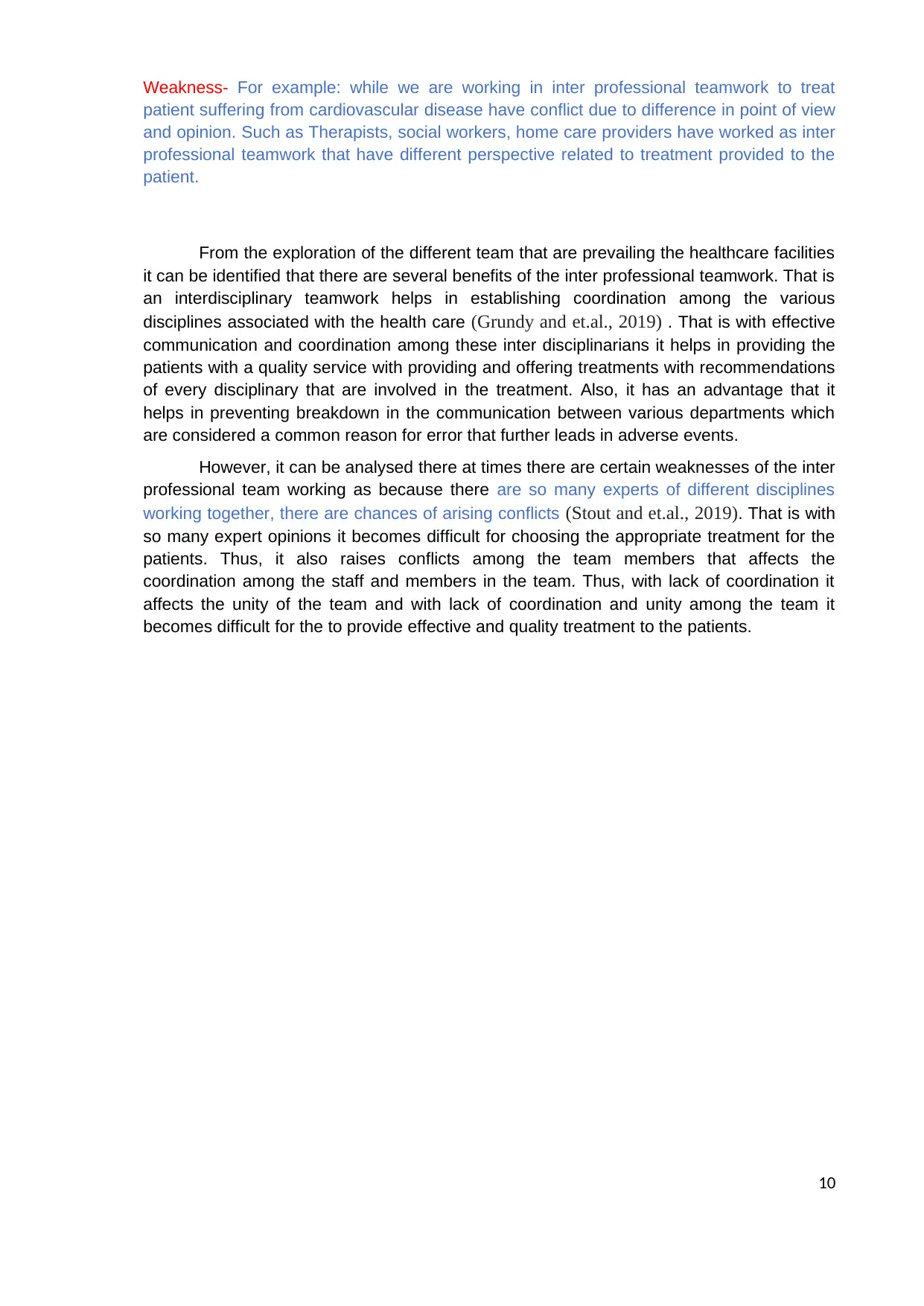
Weakness- For example: while we are working in inter professional teamwork to treat
patient suffering from cardiovascular disease have conflict due to difference in point of view
and opinion. Such as Therapists, social workers, home care providers have worked as inter
professional teamwork that have different perspective related to treatment provided to the
patient.
From the exploration of the different team that are prevailing the healthcare facilities
it can be identified that there are several benefits of the inter professional teamwork. That is
an interdisciplinary teamwork helps in establishing coordination among the various
disciplines associated with the health care (Grundy and et.al., 2019) . That is with effective
communication and coordination among these inter disciplinarians it helps in providing the
patients with a quality service with providing and offering treatments with recommendations
of every disciplinary that are involved in the treatment. Also, it has an advantage that it
helps in preventing breakdown in the communication between various departments which
are considered a common reason for error that further leads in adverse events.
However, it can be analysed there at times there are certain weaknesses of the inter
professional team working as because there are so many experts of different disciplines
working together, there are chances of arising conflicts (Stout and et.al., 2019). That is with
so many expert opinions it becomes difficult for choosing the appropriate treatment for the
patients. Thus, it also raises conflicts among the team members that affects the
coordination among the staff and members in the team. Thus, with lack of coordination it
affects the unity of the team and with lack of coordination and unity among the team it
becomes difficult for the to provide effective and quality treatment to the patients.
10
patient suffering from cardiovascular disease have conflict due to difference in point of view
and opinion. Such as Therapists, social workers, home care providers have worked as inter
professional teamwork that have different perspective related to treatment provided to the
patient.
From the exploration of the different team that are prevailing the healthcare facilities
it can be identified that there are several benefits of the inter professional teamwork. That is
an interdisciplinary teamwork helps in establishing coordination among the various
disciplines associated with the health care (Grundy and et.al., 2019) . That is with effective
communication and coordination among these inter disciplinarians it helps in providing the
patients with a quality service with providing and offering treatments with recommendations
of every disciplinary that are involved in the treatment. Also, it has an advantage that it
helps in preventing breakdown in the communication between various departments which
are considered a common reason for error that further leads in adverse events.
However, it can be analysed there at times there are certain weaknesses of the inter
professional team working as because there are so many experts of different disciplines
working together, there are chances of arising conflicts (Stout and et.al., 2019). That is with
so many expert opinions it becomes difficult for choosing the appropriate treatment for the
patients. Thus, it also raises conflicts among the team members that affects the
coordination among the staff and members in the team. Thus, with lack of coordination it
affects the unity of the team and with lack of coordination and unity among the team it
becomes difficult for the to provide effective and quality treatment to the patients.
10
Paraphrase This Document
Need a fresh take? Get an instant paraphrase of this document with our AI Paraphraser
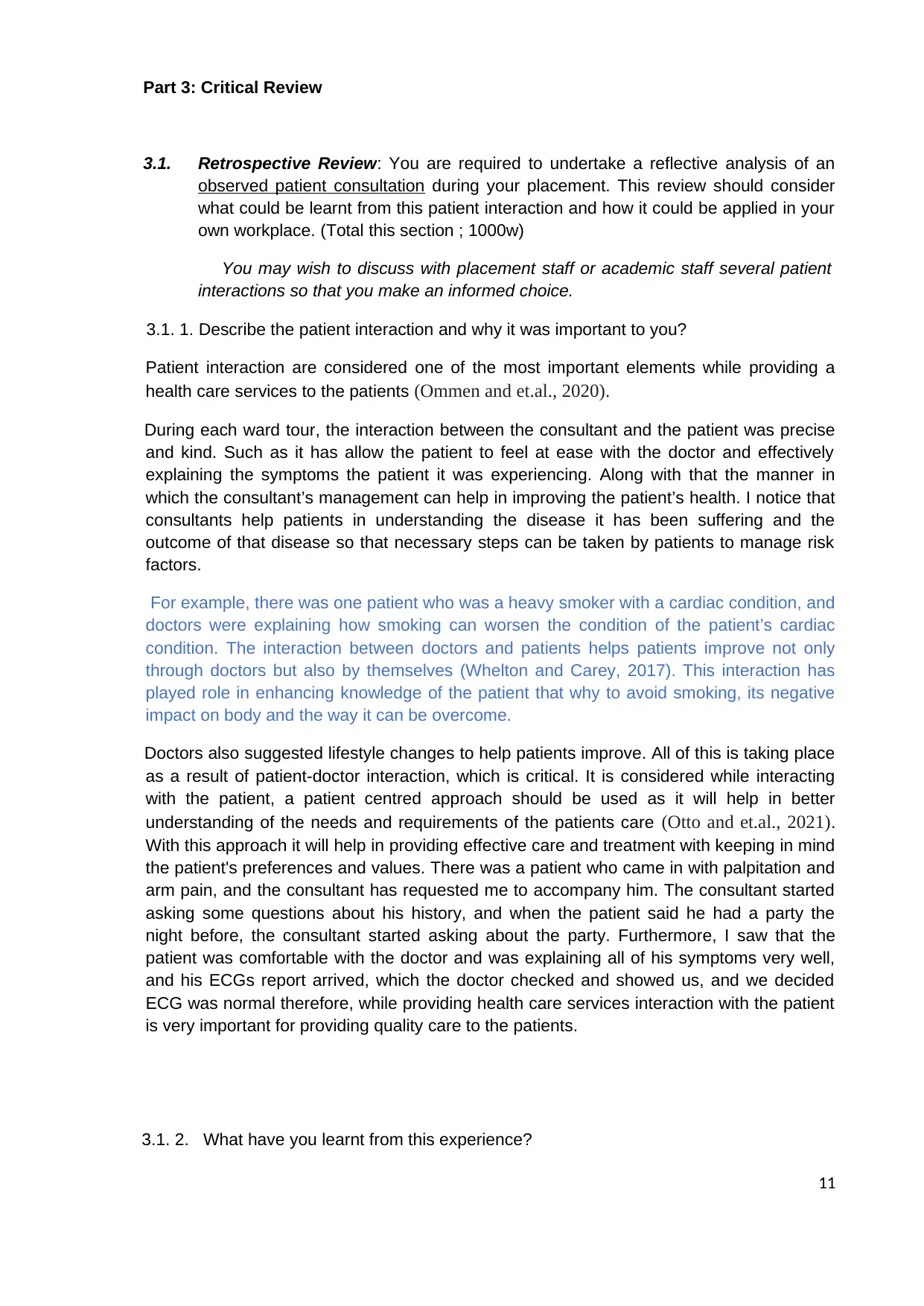
Part 3: Critical Review
3.1. Retrospective Review: You are required to undertake a reflective analysis of an
observed patient consultation during your placement. This review should consider
what could be learnt from this patient interaction and how it could be applied in your
own workplace. (Total this section ; 1000w)
You may wish to discuss with placement staff or academic staff several patient
interactions so that you make an informed choice.
3.1. 1. Describe the patient interaction and why it was important to you?
Patient interaction are considered one of the most important elements while providing a
health care services to the patients (Ommen and et.al., 2020).
During each ward tour, the interaction between the consultant and the patient was precise
and kind. Such as it has allow the patient to feel at ease with the doctor and effectively
explaining the symptoms the patient it was experiencing. Along with that the manner in
which the consultant’s management can help in improving the patient’s health. I notice that
consultants help patients in understanding the disease it has been suffering and the
outcome of that disease so that necessary steps can be taken by patients to manage risk
factors.
For example, there was one patient who was a heavy smoker with a cardiac condition, and
doctors were explaining how smoking can worsen the condition of the patient’s cardiac
condition. The interaction between doctors and patients helps patients improve not only
through doctors but also by themselves (Whelton and Carey, 2017). This interaction has
played role in enhancing knowledge of the patient that why to avoid smoking, its negative
impact on body and the way it can be overcome.
Doctors also suggested lifestyle changes to help patients improve. All of this is taking place
as a result of patient-doctor interaction, which is critical. It is considered while interacting
with the patient, a patient centred approach should be used as it will help in better
understanding of the needs and requirements of the patients care (Otto and et.al., 2021).
With this approach it will help in providing effective care and treatment with keeping in mind
the patient's preferences and values. There was a patient who came in with palpitation and
arm pain, and the consultant has requested me to accompany him. The consultant started
asking some questions about his history, and when the patient said he had a party the
night before, the consultant started asking about the party. Furthermore, I saw that the
patient was comfortable with the doctor and was explaining all of his symptoms very well,
and his ECGs report arrived, which the doctor checked and showed us, and we decided
ECG was normal therefore, while providing health care services interaction with the patient
is very important for providing quality care to the patients.
3.1. 2. What have you learnt from this experience?
11
3.1. Retrospective Review: You are required to undertake a reflective analysis of an
observed patient consultation during your placement. This review should consider
what could be learnt from this patient interaction and how it could be applied in your
own workplace. (Total this section ; 1000w)
You may wish to discuss with placement staff or academic staff several patient
interactions so that you make an informed choice.
3.1. 1. Describe the patient interaction and why it was important to you?
Patient interaction are considered one of the most important elements while providing a
health care services to the patients (Ommen and et.al., 2020).
During each ward tour, the interaction between the consultant and the patient was precise
and kind. Such as it has allow the patient to feel at ease with the doctor and effectively
explaining the symptoms the patient it was experiencing. Along with that the manner in
which the consultant’s management can help in improving the patient’s health. I notice that
consultants help patients in understanding the disease it has been suffering and the
outcome of that disease so that necessary steps can be taken by patients to manage risk
factors.
For example, there was one patient who was a heavy smoker with a cardiac condition, and
doctors were explaining how smoking can worsen the condition of the patient’s cardiac
condition. The interaction between doctors and patients helps patients improve not only
through doctors but also by themselves (Whelton and Carey, 2017). This interaction has
played role in enhancing knowledge of the patient that why to avoid smoking, its negative
impact on body and the way it can be overcome.
Doctors also suggested lifestyle changes to help patients improve. All of this is taking place
as a result of patient-doctor interaction, which is critical. It is considered while interacting
with the patient, a patient centred approach should be used as it will help in better
understanding of the needs and requirements of the patients care (Otto and et.al., 2021).
With this approach it will help in providing effective care and treatment with keeping in mind
the patient's preferences and values. There was a patient who came in with palpitation and
arm pain, and the consultant has requested me to accompany him. The consultant started
asking some questions about his history, and when the patient said he had a party the
night before, the consultant started asking about the party. Furthermore, I saw that the
patient was comfortable with the doctor and was explaining all of his symptoms very well,
and his ECGs report arrived, which the doctor checked and showed us, and we decided
ECG was normal therefore, while providing health care services interaction with the patient
is very important for providing quality care to the patients.
3.1. 2. What have you learnt from this experience?
11
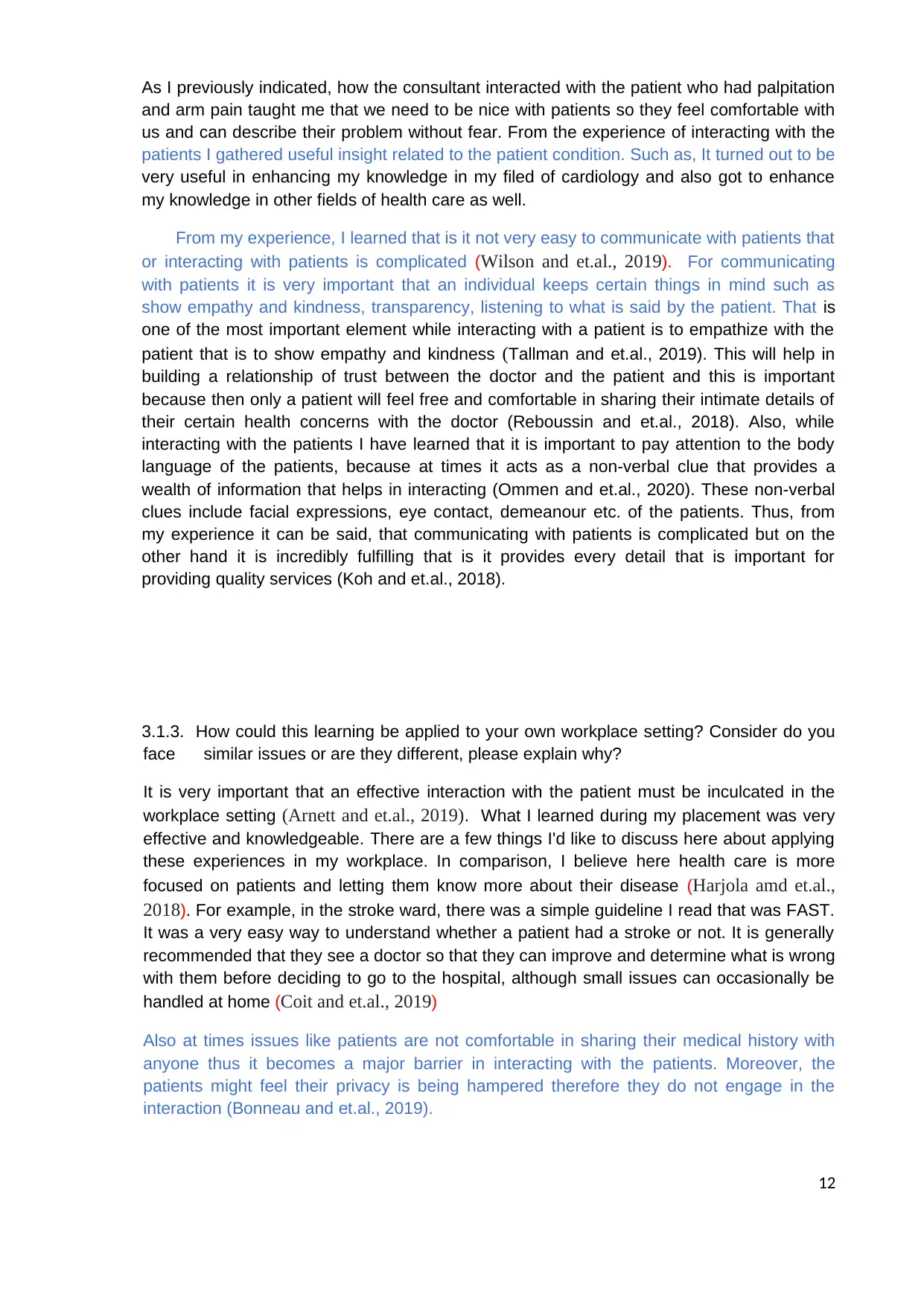
As I previously indicated, how the consultant interacted with the patient who had palpitation
and arm pain taught me that we need to be nice with patients so they feel comfortable with
us and can describe their problem without fear. From the experience of interacting with the
patients I gathered useful insight related to the patient condition. Such as, It turned out to be
very useful in enhancing my knowledge in my filed of cardiology and also got to enhance
my knowledge in other fields of health care as well.
From my experience, I learned that is it not very easy to communicate with patients that
or interacting with patients is complicated (Wilson and et.al., 2019). For communicating
with patients it is very important that an individual keeps certain things in mind such as
show empathy and kindness, transparency, listening to what is said by the patient. That is
one of the most important element while interacting with a patient is to empathize with the
patient that is to show empathy and kindness (Tallman and et.al., 2019). This will help in
building a relationship of trust between the doctor and the patient and this is important
because then only a patient will feel free and comfortable in sharing their intimate details of
their certain health concerns with the doctor (Reboussin and et.al., 2018). Also, while
interacting with the patients I have learned that it is important to pay attention to the body
language of the patients, because at times it acts as a non-verbal clue that provides a
wealth of information that helps in interacting (Ommen and et.al., 2020). These non-verbal
clues include facial expressions, eye contact, demeanour etc. of the patients. Thus, from
my experience it can be said, that communicating with patients is complicated but on the
other hand it is incredibly fulfilling that is it provides every detail that is important for
providing quality services (Koh and et.al., 2018).
3.1.3. How could this learning be applied to your own workplace setting? Consider do you
face similar issues or are they different, please explain why?
It is very important that an effective interaction with the patient must be inculcated in the
workplace setting (Arnett and et.al., 2019). What I learned during my placement was very
effective and knowledgeable. There are a few things I'd like to discuss here about applying
these experiences in my workplace. In comparison, I believe here health care is more
focused on patients and letting them know more about their disease (Harjola amd et.al.,
2018). For example, in the stroke ward, there was a simple guideline I read that was FAST.
It was a very easy way to understand whether a patient had a stroke or not. It is generally
recommended that they see a doctor so that they can improve and determine what is wrong
with them before deciding to go to the hospital, although small issues can occasionally be
handled at home (Coit and et.al., 2019)
Also at times issues like patients are not comfortable in sharing their medical history with
anyone thus it becomes a major barrier in interacting with the patients. Moreover, the
patients might feel their privacy is being hampered therefore they do not engage in the
interaction (Bonneau and et.al., 2019).
12
and arm pain taught me that we need to be nice with patients so they feel comfortable with
us and can describe their problem without fear. From the experience of interacting with the
patients I gathered useful insight related to the patient condition. Such as, It turned out to be
very useful in enhancing my knowledge in my filed of cardiology and also got to enhance
my knowledge in other fields of health care as well.
From my experience, I learned that is it not very easy to communicate with patients that
or interacting with patients is complicated (Wilson and et.al., 2019). For communicating
with patients it is very important that an individual keeps certain things in mind such as
show empathy and kindness, transparency, listening to what is said by the patient. That is
one of the most important element while interacting with a patient is to empathize with the
patient that is to show empathy and kindness (Tallman and et.al., 2019). This will help in
building a relationship of trust between the doctor and the patient and this is important
because then only a patient will feel free and comfortable in sharing their intimate details of
their certain health concerns with the doctor (Reboussin and et.al., 2018). Also, while
interacting with the patients I have learned that it is important to pay attention to the body
language of the patients, because at times it acts as a non-verbal clue that provides a
wealth of information that helps in interacting (Ommen and et.al., 2020). These non-verbal
clues include facial expressions, eye contact, demeanour etc. of the patients. Thus, from
my experience it can be said, that communicating with patients is complicated but on the
other hand it is incredibly fulfilling that is it provides every detail that is important for
providing quality services (Koh and et.al., 2018).
3.1.3. How could this learning be applied to your own workplace setting? Consider do you
face similar issues or are they different, please explain why?
It is very important that an effective interaction with the patient must be inculcated in the
workplace setting (Arnett and et.al., 2019). What I learned during my placement was very
effective and knowledgeable. There are a few things I'd like to discuss here about applying
these experiences in my workplace. In comparison, I believe here health care is more
focused on patients and letting them know more about their disease (Harjola amd et.al.,
2018). For example, in the stroke ward, there was a simple guideline I read that was FAST.
It was a very easy way to understand whether a patient had a stroke or not. It is generally
recommended that they see a doctor so that they can improve and determine what is wrong
with them before deciding to go to the hospital, although small issues can occasionally be
handled at home (Coit and et.al., 2019)
Also at times issues like patients are not comfortable in sharing their medical history with
anyone thus it becomes a major barrier in interacting with the patients. Moreover, the
patients might feel their privacy is being hampered therefore they do not engage in the
interaction (Bonneau and et.al., 2019).
12
⊘ This is a preview!⊘
Do you want full access?
Subscribe today to unlock all pages.

Trusted by 1+ million students worldwide
1 out of 21
Related Documents
Your All-in-One AI-Powered Toolkit for Academic Success.
+13062052269
info@desklib.com
Available 24*7 on WhatsApp / Email
![[object Object]](/_next/static/media/star-bottom.7253800d.svg)
Unlock your academic potential
Copyright © 2020–2025 A2Z Services. All Rights Reserved. Developed and managed by ZUCOL.





